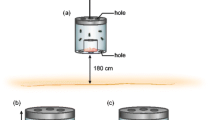Summary
Tandem pairs of the libellulid dragonfly Sympetrum vulgatum always start oviposition with contact guarding directly over the surface of shallow water, where they are exposed to green frogs (Rana esculenta). Tandems which approached locations with other pairs already present started oviposition nearby regardless of whether or not predators were actually present. With predators present attack rates during arrival were lower on tandem pairs in groups than on pairs that oviposited alone. During oviposition the attack rate on groups was similar to that on solitary pairs, but predation risk to individual tandem pairs was lower due to dilution effects. Predation risk during tandem oviposition was similar for both sexes, but females had a higher risk of falling prey to frogs during post-tandem oviposition than males. If tandems were attacked by frogs, females left the site after tandem oviposition despite the male hovering above her, and the frequency of non-contact guarded post-tandem ovipositions was reduced.
Similar content being viewed by others
References
Alcock J (1987) The effects of experimental manipulation of resources on the behavior of two calopterygid damselflies that exhibit resource-defense polygyny. Can J Zool 65:2475–2482
Arnquist G (1989) Multiple matings in a water strider: mutual benefits or intersexual conflict? Anim Behav 38:749–756
Band HT (1989) Aggregated oviposition by Chymomyza amoena (Diptera: Drosophilidae). Experientia 45:893–895
Berglund A, Rosenqvist G (1986) Reproductive costs in the prawn, Palaemon adspersus: effects on growth and predator vulnerability. Oikos 46:349–354
Bick GH, Bick JC (1965) Demography and behavior of the damselfly, Argia apicalis (Say), (Odonata: Coenagriidae). Ecology 46:461–472
Burk TE (1982) Evolutionary significance of predation on sexually signalling males. Fla Entomol 65:90–104
Convey P (1989) Post-copulatory guarding strategies in the non-territorial dragonfly Sympetrum sanguineum (Müller) (Odonata: Libellulidae). Anim Behav 37:56–63
Corbet PS (1962) A biology of dragonflies. Witherby, London
Faeth SH (1990) Aggregation of a laefminer, Cameraria sp. nov. (Davis): consequences and causes. J Anim Ecol 59:569–586
Hamilton WD (1971) Geometry for the selfish herd. J Theor Biol 31:295–311
Hassell MP, May RM (1974) Aggregation of predators and insect parasites and its effect on stability. J Anim Ecol 43:567–594
Holling CS (1959) The components of predation as revealed by a study of small mammal predation on the European pine sawfly. Can Entomol 91:293–320
Jacobs ME (1955) Studies on territorialism and sexual selection in dragonflies. Ecology 36:566–586
Kenward RE (1978) Hawks and doves: attack success and selection in Goshawk flights at Wood Pigeons. J Anim Ecol 47:449–460
Kerfoot WC, Sih A (1987) Predation: direct and indirect impacts on aquatic communities. University Press of New England. Hanover, New Hampshire
Kiltie RA, Terborgh J (1983) Observations on the behaviour of rain forest peccaries in Peru: why do white-lipped peccaries form herds?. Z Tierpsychol 62:241–255
Landeau L, Terborgh J (1986) Oddity and the “confusion effect” in predation. Anim Behav 34:1372–1380
Lazarus J (1979) The early warning function of flocking in birds: an experimental study with captive quelea. Anim Behav 26:760–777
Lima SL, Dill LM (1990) Behavioral decisions made under the risk of predation: a review and prospectus. Can J Zool 68:619–640
Martens A (1989) Aggregation of tandems in Coenagrion pulchellum (Van der Linden, 1825) during oviposition (Odonata: Coenagrionidae). Zool Anz 223:124–128
Martens A, Rehfeldt GE (1989) Female aggregation in Platycypha caligata (Odonata: Chlorocyphidae): a tactic to evade male interference during oviposition. Anim Behav 38:369–374
Michiels NK, Dhondt AA (1990) Costs and benefits associated with oviposition site selection in the dragonfly Sympetrum danae (Odonata: Libellulidae). Anim Behav 40:668–678
Milinski M (1979) Can an experienced predator overcome the confusion of swarming prey more easily? Anim Behav 27:1122–1126
Morse DH (1980) Behavioural mechanisms in ecology. Harvard University Press, Cambridge
Ottolenghi C (1987) Reproductive behaviour of Sympetrum striolatum (Charp.) at an artificial pond in northern Italy (Anisoptera: Libellulidae). Odonatologica 16:297–306
Pajunen VI (1962) Studies on the population ecology of Leucorrhinia dubia V.d. Lind. (Odon., Libellulidae). Ann Zool Soc Vanamo 24:1–79
Pulliam HR, Caraco T (1984) Living in groups: is there an optimal group size? In: Krebs JR, Davies NB (eds) Behavioural ecology. Sinauer, Sunderland, pp 122–147
Rehfeldt GE (1990a) Anti-predator strategies in oviposition site selection of Pyrrhosoma nymphula (Zygoptera: Odonata). Oecologia 84:233–237
Rehfeldt GE (1990b) The influence of male interference on female perching behaviour before and during oviposition in libellulid dragonflies (Anisoptera). Odonatologica 18:365–372
Rehfeldt GE (1991) The influence of male guarding position on predation risk during oviposition in the damselfly Coenagrion puella (Odonata: Coenagrionidae). Odonatologica 20:69–74
Robert PA (1958) Les libellulis (Odonates). Delachaux & Niestlé, Neuchâtel
Rüppell G, Rudolph R, Hadrys H (1987) Argia moesta (Coenagrionidae) — Verhalten bei der Eiablage in der Gruppe. Publ Wiss Filmen, Sekt Biel Ser 19:1–9
Schmidt E (1987) Notes on a peculiar reproductive behaviour and on habitat recognition in Sympetrum internum Montgomery (Anisoptera: Libellulidae). Notul Odonatol 2:144–147
Sillén-Tullberg B, Leimar O (1988) The evolution of gregariousness in distasteful insects as a defense against predators. Am Nat 132:723–734
Treherne JE, Foster WA (1980) The effects of group size on predator avoidance in a marine insect. Anim Behav 28:1119–1122
Turchin P, Kareiva P (1989) Aggregation in Aphis varians: an effective strategy for reducing predation risk. Ecology 70:1008–1016
Waage JK (1979) Adaptive significance of postcopulatory guarding of mates and nonmates by male Calopteryx maculata (Odonata). Behav Ecol Scoiobiol 6:147–154
Waage JK (1987) Choice and utilization of oviposition sites by female Calopteryx maculata (Odonata, Calopterygidae). Behav Ecol Sociobiol 20:439–446
Wolf LL, Waltz EC (1988) Oviposition site selection and spatial predictability of female White-faced dragonflies (Leucorrhinia intacta) (Odonata: Libellulidae). Ethology 78:306–320
Author information
Authors and Affiliations
Rights and permissions
About this article
Cite this article
Rehfeldt, G.E. Aggregation during oviposition and predation risk in Sympetrum vulgatum L. (Odonata: Libellulidae). Behav Ecol Sociobiol 30, 317–322 (1992). https://doi.org/10.1007/BF00170597
Received:
Accepted:
Issue Date:
DOI: https://doi.org/10.1007/BF00170597




